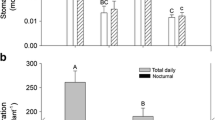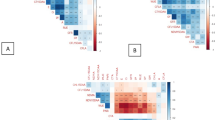Abstract
Main conclusion
Nocturnal transpiration, through its circadian control, plays a role in modulating daytime transpiration response to increasing evaporative demand, to potentially enable drought tolerance in wheat.
Limiting plant transpiration rate (TR) in response to increasing vapor pressure deficit (VPD) has been suggested to enable drought tolerance through water conservation. However, there is very little information on the extent of diversity of TR response curves to “true” VPD (i.e., independent from temperature). Furthermore, new evidence indicate that water-saving could operate by modulating nocturnal TR (TRN), and that this response might be coupled to daytime gas exchange. Based on 3 years of experimental data on a diverse group of 77 genotypes from 25 countries and 5 continents, a first goal of this study was to characterize the functional diversity in daytime TR responses to VPD and TRN in wheat. A second objective was to test the hypothesis that these traits could be coupled through the circadian clock. Using a new gravimetric phenotyping platform that allowed for independent temperature and VPD control, we identified three and fourfold variation in daytime and nighttime responses, respectively. In addition, TRN was found to be positively correlated with slopes of daytime TR responses to VPD, and we identified pre-dawn variation in TRN that likely mediated this relationship. Furthermore, pre-dawn increase in TRN positively correlated with the year of release among drought-tolerant Australian cultivars and with the VPD threshold at which they initiated water-saving. Overall, the study indicates a substantial diversity in TR responses to VPD that could be leveraged to enhance fitness under water-limited environments, and that TRN and its circadian control may play an important role in the expression of water-saving.






Similar content being viewed by others
Abbreviations
- TR:
-
Transpiration rate
- TRN :
-
Nighttime transpiration rate
- VPD:
-
Vapor pressure deficit
- VPDTh :
-
VPD threshold
- GraPh:
-
Gravimetric phenotyping
References
Belko N, Zaman-Allah M, Diop NN, Cisse N, Zombre G, Ehlers JD, Vadez V (2013) Restriction of transpiration rate under high vapour pressure deficit and non-limiting water conditions is important for terminal drought tolerance in cowpea. Plant Biol 15:304–316
Bramley H, Turner NC, Turner DW, Tyerman SD (2009) Roles of morphology, anatomy, and aquaporins in determining contrasting hydraulic behavior of roots. Plant Physiol 150:348–364
Christman MA, Richards JH, McKay JK, Stahl EA, Juenger TE, Donovan LA (2008) Genetic variation in Arabidopsis thaliana for night-time leaf conductance. Plant Cell Environ 31:1170–1178
Claverie E, Meunier F, Javaux M, Sadok W (2018) Increased contribution of wheat nocturnal transpiration to daily water use under drought. Physiol Plant 162:290–300
Coupel-Ledru A, Lebon E, Christophe A, Gallo A, Gago P, Pantin F, Doligez A, Simonneau T (2016) Reduced nighttime transpiration is a relevant breeding target for high water-use efficiency in grapevine. Proc Natl Acad Sci USA 113:8963–8968
Drake PL, Froend RH, Franks PJ (2013) Smaller, faster stomata: scaling of stomatal size, rate of response, and stomatal conductance. J Exp Bot 64:495–505
Fletcher AL, Sinclair TR, Allen LH (2007) Transpiration responses to vapour pressure deficit in well watered ‘slow-wilting’ and commercial soybean. Environ Exp Bot 61:145–151
Kholová J, Zindy P, Malayee S, Baddam R, Murugesan T, Kaliamoorthy S, Hash CT, Votrubová O, Soukup A, Kocová M, Niang M, Vadez V (2016) Component traits of plant water use are modulated by vapour pressure deficit in pearl millet (Pennisetum glaucum (L.) R.Br.). Funct Plant Biol 43:423–437
Kirkegaard JA, Hunt JR (2010) Increasing productivity by matching farming system management and genotype in water-limited environments. J Exp Bot 61:4129–4143
Kudoyarova G, Veselova S, Hartung W, Farhutdinov R, Veselov D, Sharipova G (2011) Involvement of root ABA and hydraulic conductance in the control of water relations in wheat plants exposed to increased evaporative demand. Planta 233:87–94
Kupper P, Rohula G, Saksing L, Sellin A, Lõhmus K, Ostonen I, Helmisaari H-S, Sõber A (2012) Does soil nutrient availability influence night-time water flux of aspen saplings? Environ Exp Bot 82:37–42
Kuwagata T, Ishikawa-Sakurai J, Hayashi H, Nagasuga K, Fukushi K, Ahamed A, Takasugi K, Katsuhara M, Murai-Hatano M (2012) Influence of low air humidity and low root temperature on water uptake, growth and aquaporin expression in rice plants. Plant Cell Physiol 53:1418–1431
Lee SH, Chung GC, Jang JY, Ahn SJ, Zwiazek JJ (2012) Overexpression of PIP2;5 aquaporin alleviates effects of low root temperature on cell hydraulic conductivity and growth in Arabidopsis. Plant Physiol 159:479–488
Messina CD, Sinclair TR, Hammer GL, Curan D, Thompson J, Oler Z, Gho C, Cooper M (2015) Limited-transpiration trait may increase maize drought tolerance in the US corn belt. Agron J 107:1978–1986
Motulsky HJ, Brown RE (2006) Detecting outliers when fitting data with nonlinear regression—a new method based on robust nonlinear regression and the false discovery rate. BMC Bioinformatics 7:123
Passioura J (2012) Phenotyping for drought tolerance in grain crops: when is it useful to breeders? Funct Plant Biol 39:851–859
Penman HL (1948) Natural evaporation from open water, bare soil, and grass. Proc R Soc Lond Ser A 193:120–146
R Development Core Team (2017) R: a language and environment for statistical computing. R Foundation for Statistical Computing, Vienna. http://www.R-project.org
Rawson HM, Clarke JM (1989) Nocturnal transpiration in wheat. Aust J Plant Physiol 15:397–406
Resco de Dios V, Gessler A (2018) Circadian regulation of photosynthesis and transpiration from genes to ecosystems. Environ Exp Bot 152:37–48
Resco de Dios V, Roy J, Ferrio JP, Alday JG, Landais D, Milcu A, Gessler A (2015) Processes driving nocturnal transpiration and implications for estimating land evapotranspiration. Sci Rep 5:10975
Resco de Dios V, Loik ME, Smith R, Aspinwall MJ, Tissue DT (2016) Genetic variation in circadian regulation of nocturnal stomatal conductance enhances carbon assimilation and growth. Plant Cell Environ 39:3–11
Richards RA, Passioura JB (1989) A breeding program to reduce the diameter of the major xylem vessel in the seminal roots of wheat and its effect on grain yield in rain-fed environments. Aust J Agr Res 40:943–950
Rosas-Anderson P, Taggart MJ, Heitman JL, Miller GL, Sinclair TR, Rufty TW (2018) Partitioning between evaporation and transpiration from Agrostis stolonifera L. during light and dark periods. Agr Forest Meteorol 260–261:73–79
Ryan AC, Dodd IC, Rothwell SA, Jones R, Tardieu F, Draye X, Davies WJ (2016) Gravimetric phenotyping of whole plant transpiration responses to atmospheric vapour pressure deficit identifies genotypic variation in water use efficiency. Plant Sci 251:101–109
Sadok W (2016) The circadian life of nocturnal water use: when late-night decisions help improve your day. Plant Cell Environ 39:1–2
Sadok W, Schoppach R (2019) Potential involvement of root auxins in drought tolerance by modulating nocturnal and daytime water use in wheat. Ann. Bot. https://doi.org/10.1093/aob/mcz023
Sadok W, Sinclair TR (2010) Transpiration response of ‘slow-wilting’ and commercial soybean (Glycine max (L) Merr.) genotypes to three aquaporin inhibitors under high evaporative demand. J Exp Bot 61:821–829
Schoppach R, Sadok W (2012) Differential sensitivities of transpiration to evaporative demand and soil water deficit among wheat elite cultivars indicate different strategies for drought tolerance. Environ Exp Bot 84:1–10
Schoppach R, Claverie E, Sadok W (2014a) Genotype-dependent influence of night-time vapour pressure deficit on night-time transpiration and daytime gas exchange in wheat. Funct Plant Biol 41:963–971
Schoppach R, Wauthelet D, Jeanguenin L, Sadok W (2014b) Conservative water use under high evaporative demand associated with smaller root metaxylem and limited trans-membrane water transport in wheat. Funct Plant Biol 41:257–269
Schoppach R, Taylor JD, Majerus E, Claverie E, Baumann U, Suchecki R, Fleury D, Sadok W (2016) High resolution mapping of traits related to whole-plant transpiration under increasing evaporative demand in wheat. J Exp Bot 67:2847–2860
Schoppach R, Fleury D, Sinclair TR, Sadok W (2017) Transpiration sensitivity to evaporative demand across 120 years of breeding of Australian wheat cultivars. J Agron Crop Sci 203:219–226
Shekoofa A, Sinclair TR, Messina CD, Cooper M (2016) Variation among maize hybrids in response to high vapor pressure deficit at high temperatures. Crop Sci 56:392–396
Sinclair TR, Muchow RC (2001) System analysis of plant traits to increase grain yield on limited water supplies. Agron J 93:263–270
Sinclair TR, Hammer GL, van Oosterom EJ (2005) Potential yield and water- use efficiency benefits in sorghum from limited maximum transpiration rate. Funct Plant Biol 32:945–952
Sinclair TR, Messina CD, Beatty A, Samples M (2010) Assessment across the United States of the benefits of altered soybean drought traits. Agron J 102:475–482
Sinclair TR, Wherle BG, Dukes MD, Cathey SE (2014) Penman’s sink-strength model as an improved approach to estimating plant canopy transpiration. Agr Forest Meteorol 197:136–141
Sinclair TR, Devi J, Shekoofa A, Choudhary S, Sadok W, Vadez V, Riar M, Rufty T (2017) Limited-transpiration response to high vapor pressure deficit in crop species. Plant Sci 260:109–118
Tamang BG, Sadok W (2018) Nightly business: links between daytime canopy conductance, nocturnal transpiration and its circadian control illuminate physiological trade-offs in maize. Environ Exp Bot 148:192–202
Tanner CB, Sinclair TR (1983) Efficient water use in crop production: research or re- search? In: Taylor HM, Wayne JR, Thomas SR (eds) Limitations to efficient water use in crop production. American Society of Agronomy, Crop Science Society of America, Soil Science Society of America, Madison, pp 1–27
Vadez V, Kholová J, Medina S, Kakkera A, Anderberg H (2014) Transpiration efficiency: new insights into an old story. J Exp Bot 65:6141–6153
Yang Z, Sinclair TR, Zhu M, Messina C, Cooper M, Hammer GL (2012) Temperature effect on transpiration response of maize plants to vapour pressure deficit. Environ Exp Bot 78:157–162
Acknowledgements
This work was supported by the Minnesota Agricultural Experiment Station (Project# MIN-13-095), the Minnesota Wheat Research & Promotion Council (Projects# 00062299 and 00070003), the Belgian National Fund for Scientific Research (FNRS, contract# 1.E038.13), and by the National Science Foundation/Civilian Research & Development Foundation (Award# OISE-16-62788-0).
Author information
Authors and Affiliations
Corresponding author
Additional information
Publisher's Note
Springer Nature remains neutral with regard to jurisdictional claims in published maps and institutional affiliations.
Electronic supplementary material
Below is the link to the electronic supplementary material.
Rights and permissions
About this article
Cite this article
Tamang, B.G., Schoppach, R., Monnens, D. et al. Variability in temperature-independent transpiration responses to evaporative demand correlate with nighttime water use and its circadian control across diverse wheat populations. Planta 250, 115–127 (2019). https://doi.org/10.1007/s00425-019-03151-0
Received:
Accepted:
Published:
Issue Date:
DOI: https://doi.org/10.1007/s00425-019-03151-0




